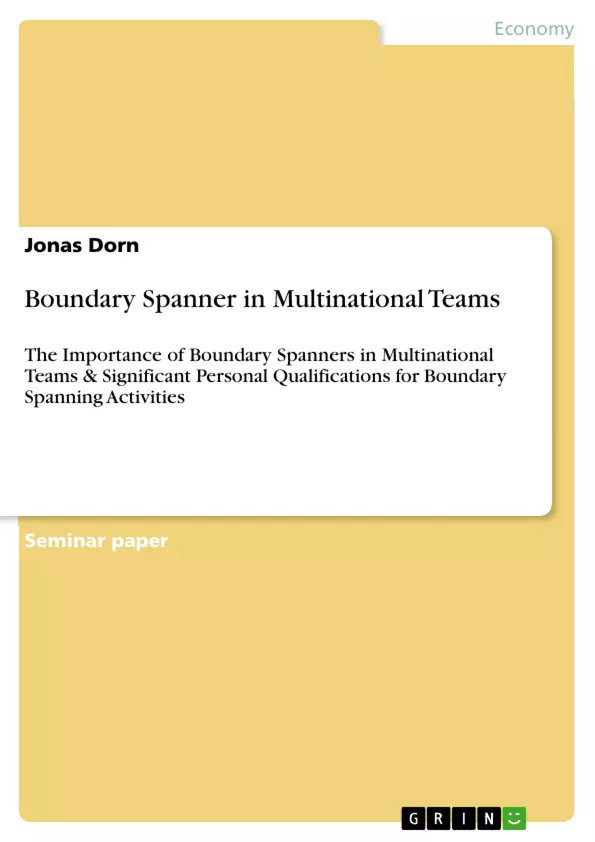Increasing dynamicity of global business environment necessitates the adoption of boundary spanning in order for an organization to survive global competitiveness. This essay aims to identify personal characteristics that an invidividual should bring in order to realize a successful boundary spanner in a multinational team.
In the study, it was noted that the task for boundary spanners is to bridge intergroup challenges facing organizations by establishing sharing ties between different groups in order to enable the flow of knowledge, information, resources and people. The boundary spanning activities thus enables an organization to achieve a common team spirit and hence ensures efficient and effective work flow. To effectively achieve boundary spanners‘ role, an individual should possess negotiation skills, mediation skills, assimilation skills, coaching and institutional engagement skills. The person should further possess personal qualities of imagination, empathy, optimism and modesty are more likely to be successful at acquiring the skill sets required for a successful boundary spanning. Tactics for boundary spanning leadership that needs to be considered for a successful boundary spanning include: boundary suspending, boundary reframing, boundary nesting, and weaving tactic. The leadership behaviour for boundary spanning should create and maintain favourable relationships with not only the peers but also with the superiors and outsiders who provide information, political support, and resources. The leaders need to be influential to get essential resources and support from key management. They need to have good negotiation skills. The leaders should further be sensitive to changes in the external environment by analysing information concerning relevant events and changes within the external surroundings of an organization. The study noted that one of the key sources of information exchange and communication is boundary spanners, which usually find much relevance in culturally distant marketplaces. However, one of the challenges is that their performance may be hard to measure, and the process may need much time and resources. At times, the boundary spanners from opposite ends may fail to reach a consensus after long time engagements in networking, external watching, and representing.
Inhaltsverzeichnis (Table of Contents)
- Introduction
- Literature Review
- The Role of Boundary Spanner
- Establishing social bridges to improve team success.
- The impacts of boundary spanning leadership on the team success.
- Boundary Spanning Leadership towards Enhanced Team Performance.
- Boundary spanning Behaviours of leaders
- Buffering
- Collaborating
- Representing.
- Negotiating
- External Monitoring.
- Personal characteristics of Boundary Spanner Leaders
- Good Communication in Boundary Spanning
- Discussion
- Conclusion
Zielsetzung und Themenschwerpunkte (Objectives and Key Themes)
This thesis aims to identify the personal characteristics required to become a successful boundary spanner in a multinational team. The study explores how boundary spanners bridge intergroup challenges by establishing shared ties and enabling the flow of knowledge, information, resources, and people. The research investigates the crucial role of boundary spanning in achieving a common team spirit and ensuring efficient and effective work flow in multinational teams.
- The role of boundary spanners in multinational teams
- Personal characteristics of successful boundary spanners
- The impact of boundary spanning leadership on team performance
- Strategies for boundary spanning leadership
- The importance of communication in boundary spanning
Zusammenfassung der Kapitel (Chapter Summaries)
The introduction establishes the context of boundary spanning in the dynamic global business environment, highlighting the challenges of bridging social identity boundaries and the need for effective leadership. It emphasizes the role of boundary spanners in fostering collaboration and knowledge sharing within multinational teams.
The literature review delves into the key role of boundary spanners in gathering information, obtaining feedback, and translating it back into the organization. It examines the skills and capabilities required for successful boundary spanning, including negotiation, mediation, assimilation, coaching, and institutional engagement skills. The chapter also emphasizes the importance of personal qualities such as imagination, empathy, optimism, and modesty.
Schlüsselwörter (Keywords)
Boundary spanning, multinational teams, leadership, social identity, communication, knowledge sharing, intergroup relations, negotiation, mediation, assimilation, coaching, emotional intelligence.
- Citar trabajo
- Jonas Dorn (Autor), 2014, Boundary Spanner in Multinational Teams, Múnich, GRIN Verlag, https://www.grin.com/document/1168065



